Answer
64.8k+ views
Hint: Centre of mass of a system is the point where mass of the system is concentrated. For a system of mass m, the centre of mass can be calculated using mass and the position coordinates. We find the coordinates of the centre of mass using the corresponding formula depending on which axis is the symmetry axis. The number of coordinates that describe the centre of mass will depend on the dimension of the object.
Formula used:
The coordinates of the centre of mass are approximately given by
i) $X = \dfrac{1}{M}\int {xdm} $(X stands for the X-coordinate of the centre of mass, M stands for the mass of the particle, x stands for the x coordinate of the particle)
ii) $Y = \dfrac{1}{M}\int {ydm} $ (Y stands for the y coordinate of the centre of mass, y stands for the y coordinate of the particle)
iii) $Z = \dfrac{1}{M}\int {zdm} $(Z stands for the z coordinate of the centre of mass, z stands for the z coordinate of the particle)
Complete step by step solution:
A) CM of a uniform semi-circular disc of radius R:
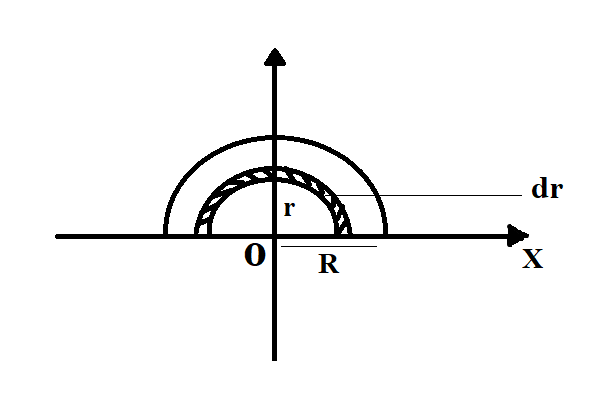
Let us consider a semi-circular disc of mass M and radius R.
Area of the disc = $\dfrac{{\pi {R^2}}}{2}$
Mass per unit area of the disc, $m = \dfrac{M}{{\dfrac{{\pi {R^2}}}{2}}} = \dfrac{{2M}}{{\pi {R^2}}}$
Area of the small element, dr = $\dfrac{1}{2}(\pi r{(r + dr)^2} - \pi {r^2})$ (calculating the area of the small element)
$\Rightarrow dr = \dfrac{1}{2}(\pi ({r^2} + d{r^2} + 2rdr) - \pi {r^2}) $
$\Rightarrow dr= \dfrac{1}{2}(2\pi rdr),(\because d{r^2} < < 1)$ ($\pi {r^2}$ is cancelled and $\pi d{r^2}$ is neglected because $d{r^2} \ll 1$)
$\Rightarrow dr= \pi rdr$
Mass of the small element dm is obtained by multiplying the mass per unit area and the area of the small element
The mass of the small element, $dm = \left( {\pi rdr} \right) \times \left( {\dfrac{{2M}}{{\pi {R^2}}}} \right)$ (on the calculation, we get)
$ \Rightarrow dm= \dfrac{{2Mr}}{{{R^2}}}dr$
The coordinates of the small element dr $(x,y)$= $\left( {0,\dfrac{{2r}}{\pi }} \right)$ $(x = 0,y = \dfrac{{2r}}{\pi })$
Let us take X and Y to be the coordinates for centre of mass,
$X = 0$(Due to the symmetry of the disc)
$Y = \dfrac{1}{M}\int {ydm} $
$Y = \dfrac{1}{M}\int\limits_0^R {\left( {\dfrac{{2r}}{\pi }} \right)} \left( {\dfrac{{2Mr}}{{{R^2}}}} \right)dr$
Integrating the above equation and applying the limits we get,
$Y = \left( {\dfrac{4}{{\pi {R^2}}}} \right)\left( {\dfrac{{{R^3}}}{3}} \right)$
$Y = \dfrac{{4R}}{{3\pi }}$
B) CM of a uniform semi-circular ring of radius R:
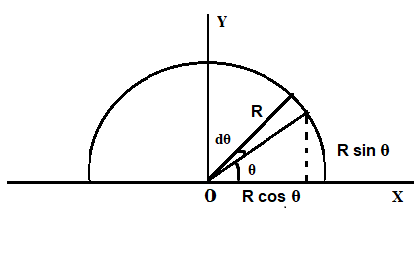
First we calculate the radius of a semi-circular ring with radius R and mass M
Total length of semi-circular ring $ = \dfrac{{2\pi R}}{2} = \pi R$
Mass per unit length of the semi-circular ring $ = \dfrac{M}{{\pi R}}$
The length of the small element is $ = Rd\theta $
Multiplying the mass per unit length and the length of the small element
The mass of the small element $dm = \left( {\dfrac{M}{{\pi R}}} \right)\left( {Rd\theta } \right) = \dfrac{M}{\pi }d\theta $
According to symmetry the x coordinate is zero
$X = \dfrac{1}{M}\int {xdm} $$ = \dfrac{1}{M}\int\limits_0^\pi {\left( {R\cos \theta } \right)} \dfrac{M}{\pi }d\theta = 0$
The y coordinate can be calculated using the above equation
$Y = \dfrac{1}{M}\int {ydm} $$ = \dfrac{1}{M}\int\limits_0^\pi {\left( {R\sin \theta } \right)} \left( {\dfrac{M}{\pi }} \right)d\theta = \dfrac{{2R}}{\pi }$……………………………(1)
To find the centre of mass of semi-circular ring with radius $\dfrac{{2R}}{3}$ can be obtained by substituting this value instead of R in (A)
$Y = \dfrac{2}{\pi } \times \dfrac{{2R}}{3} = \dfrac{{4R}}{{3\pi }}$
C) CM of a solid hemisphere:
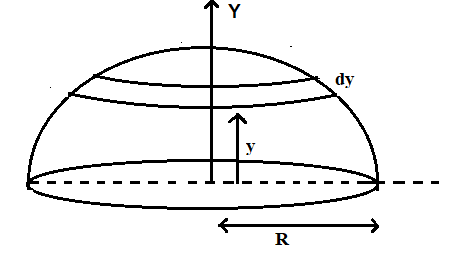
Consider a hemisphere of mass M and radius R
The radius of the disc, $r = \sqrt {{R^2} - {y^2}} $………………………………………(1)
Mass of the disc at a height y, $ = $$dM = \left( {\dfrac{{3M}}{{2\pi {R^3}}}} \right)\left( {\pi {r^2}dy} \right)$……………………………………..(2)
(r is the radius of the small disc at a height y)
Substitute equation $(1)$ in equation $(2)$
\[dM = \left( {\dfrac{{3M}}{{2\pi {R^3}}}} \right) \times \left( {\pi \left( {{R^2} - {y^2}} \right)dy} \right)\]
The Y coordinate can be obtained by the equation $Y = \dfrac{1}{M}\int {ydm} $
$Y = \dfrac{1}{M}\int {y\left( {\dfrac{{3M}}{{2{R^3}}}} \right) \times \left( {{R^2} - {y^2}} \right)dy} $
We have to integrate the above equation from 0 to R
\[Y = \dfrac{1}{M}\int\limits_0^R {\dfrac{{3M}}{{{R^3}}}\left( {{R^2} - {y^2}} \right) \times y} \]
$Y = \dfrac{3}{{2{R^3}}}\int\limits_0^R {\left( {{R^2}y - {y^3}} \right)dy} $
After integrating and applying the limits,
$Y = \left( {\dfrac{3}{{2{R^2}}}} \right)\left( {\dfrac{{{R^4}}}{2}} \right) - \dfrac{{{R^4}}}{4} $
$Y = \dfrac{{3R}}{8} $
D) CM of a solid hemisphere shell of radius R:
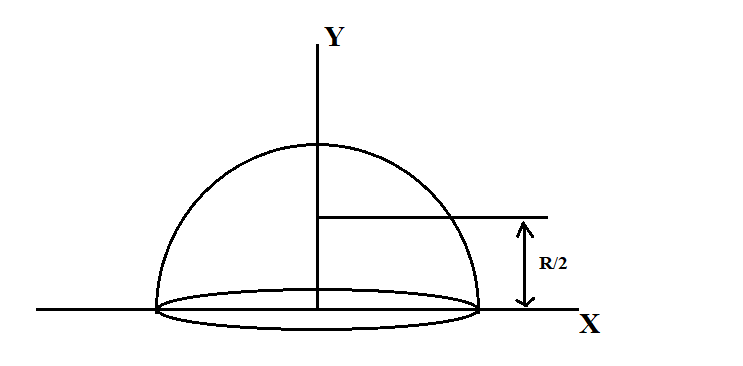
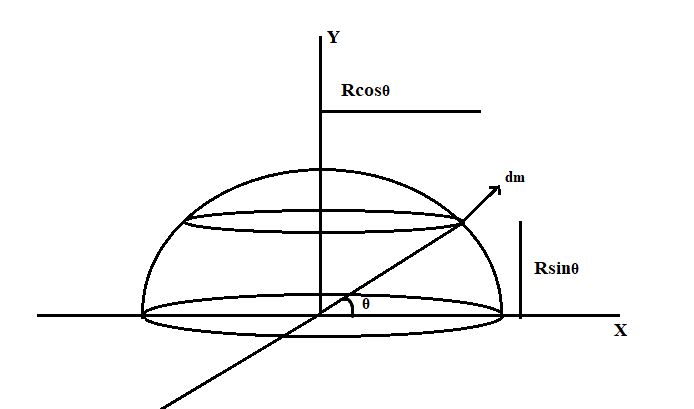
Consider a hemispherical shell of radius R and mass M.
Consider a small element as shown in the figure having radius $R\cos \theta $
The mass per unit length is given by $\dfrac{m}{{2\pi {R^2}}}$
The mass of the small element is,$dm = \left( {2\pi \cos \theta } \right)Rd\theta \times \dfrac{m}{{2\pi {R^2}}}$
$dm = m\cos \theta d\theta $
To find the coordinate of centre of mass, we use the equation ,$Y = \dfrac{1}{M}\int {ydm} $
Integrating from $0$to $\dfrac{\pi }{2}$
$Y = \dfrac{1}{M}\int\limits_0^{\dfrac{\pi }{2}} {R\sin \theta \cos \theta md\theta } $ (use the identity $\left( {\sin \theta \cos \theta = \dfrac{{\sin 2\theta }}{2}} \right)$ in the equation)
$Y = \dfrac{R}{2}\int\limits_0^{\dfrac{\pi }{2}} {\sin 2\theta d\theta } $
$Y = \dfrac{R}{2}\left[ {\dfrac{{ - \cos 2\theta }}{2}} \right]_0^{\dfrac{\pi }{2}}$
Substituting the limits, we get
$Y = \dfrac{R}{2}\left[ {\dfrac{1}{2} + \dfrac{1}{2}} \right] $
$Y = \dfrac{R}{2} \times 1 = \dfrac{R}{2} $
Hence, the correct options are (B) and (D).
Note:Since in question we have semi-circular and hemispherical geometry we take the area and volume to be half of the value of circular and spherical geometry. Consider a small element and calculate its mass. Substitute in the equation for a coordinate to find the coordinate of the centre of mass. Due to symmetry, the x coordinate is usually zero for geometries with their centre at the origin.
Formula used:
The coordinates of the centre of mass are approximately given by
i) $X = \dfrac{1}{M}\int {xdm} $(X stands for the X-coordinate of the centre of mass, M stands for the mass of the particle, x stands for the x coordinate of the particle)
ii) $Y = \dfrac{1}{M}\int {ydm} $ (Y stands for the y coordinate of the centre of mass, y stands for the y coordinate of the particle)
iii) $Z = \dfrac{1}{M}\int {zdm} $(Z stands for the z coordinate of the centre of mass, z stands for the z coordinate of the particle)
Complete step by step solution:
A) CM of a uniform semi-circular disc of radius R:

Let us consider a semi-circular disc of mass M and radius R.
Area of the disc = $\dfrac{{\pi {R^2}}}{2}$
Mass per unit area of the disc, $m = \dfrac{M}{{\dfrac{{\pi {R^2}}}{2}}} = \dfrac{{2M}}{{\pi {R^2}}}$
Area of the small element, dr = $\dfrac{1}{2}(\pi r{(r + dr)^2} - \pi {r^2})$ (calculating the area of the small element)
$\Rightarrow dr = \dfrac{1}{2}(\pi ({r^2} + d{r^2} + 2rdr) - \pi {r^2}) $
$\Rightarrow dr= \dfrac{1}{2}(2\pi rdr),(\because d{r^2} < < 1)$ ($\pi {r^2}$ is cancelled and $\pi d{r^2}$ is neglected because $d{r^2} \ll 1$)
$\Rightarrow dr= \pi rdr$
Mass of the small element dm is obtained by multiplying the mass per unit area and the area of the small element
The mass of the small element, $dm = \left( {\pi rdr} \right) \times \left( {\dfrac{{2M}}{{\pi {R^2}}}} \right)$ (on the calculation, we get)
$ \Rightarrow dm= \dfrac{{2Mr}}{{{R^2}}}dr$
The coordinates of the small element dr $(x,y)$= $\left( {0,\dfrac{{2r}}{\pi }} \right)$ $(x = 0,y = \dfrac{{2r}}{\pi })$
Let us take X and Y to be the coordinates for centre of mass,
$X = 0$(Due to the symmetry of the disc)
$Y = \dfrac{1}{M}\int {ydm} $
$Y = \dfrac{1}{M}\int\limits_0^R {\left( {\dfrac{{2r}}{\pi }} \right)} \left( {\dfrac{{2Mr}}{{{R^2}}}} \right)dr$
Integrating the above equation and applying the limits we get,
$Y = \left( {\dfrac{4}{{\pi {R^2}}}} \right)\left( {\dfrac{{{R^3}}}{3}} \right)$
$Y = \dfrac{{4R}}{{3\pi }}$
B) CM of a uniform semi-circular ring of radius R:

First we calculate the radius of a semi-circular ring with radius R and mass M
Total length of semi-circular ring $ = \dfrac{{2\pi R}}{2} = \pi R$
Mass per unit length of the semi-circular ring $ = \dfrac{M}{{\pi R}}$
The length of the small element is $ = Rd\theta $
Multiplying the mass per unit length and the length of the small element
The mass of the small element $dm = \left( {\dfrac{M}{{\pi R}}} \right)\left( {Rd\theta } \right) = \dfrac{M}{\pi }d\theta $
According to symmetry the x coordinate is zero
$X = \dfrac{1}{M}\int {xdm} $$ = \dfrac{1}{M}\int\limits_0^\pi {\left( {R\cos \theta } \right)} \dfrac{M}{\pi }d\theta = 0$
The y coordinate can be calculated using the above equation
$Y = \dfrac{1}{M}\int {ydm} $$ = \dfrac{1}{M}\int\limits_0^\pi {\left( {R\sin \theta } \right)} \left( {\dfrac{M}{\pi }} \right)d\theta = \dfrac{{2R}}{\pi }$……………………………(1)
To find the centre of mass of semi-circular ring with radius $\dfrac{{2R}}{3}$ can be obtained by substituting this value instead of R in (A)
$Y = \dfrac{2}{\pi } \times \dfrac{{2R}}{3} = \dfrac{{4R}}{{3\pi }}$
C) CM of a solid hemisphere:

Consider a hemisphere of mass M and radius R
The radius of the disc, $r = \sqrt {{R^2} - {y^2}} $………………………………………(1)
Mass of the disc at a height y, $ = $$dM = \left( {\dfrac{{3M}}{{2\pi {R^3}}}} \right)\left( {\pi {r^2}dy} \right)$……………………………………..(2)
(r is the radius of the small disc at a height y)
Substitute equation $(1)$ in equation $(2)$
\[dM = \left( {\dfrac{{3M}}{{2\pi {R^3}}}} \right) \times \left( {\pi \left( {{R^2} - {y^2}} \right)dy} \right)\]
The Y coordinate can be obtained by the equation $Y = \dfrac{1}{M}\int {ydm} $
$Y = \dfrac{1}{M}\int {y\left( {\dfrac{{3M}}{{2{R^3}}}} \right) \times \left( {{R^2} - {y^2}} \right)dy} $
We have to integrate the above equation from 0 to R
\[Y = \dfrac{1}{M}\int\limits_0^R {\dfrac{{3M}}{{{R^3}}}\left( {{R^2} - {y^2}} \right) \times y} \]
$Y = \dfrac{3}{{2{R^3}}}\int\limits_0^R {\left( {{R^2}y - {y^3}} \right)dy} $
After integrating and applying the limits,
$Y = \left( {\dfrac{3}{{2{R^2}}}} \right)\left( {\dfrac{{{R^4}}}{2}} \right) - \dfrac{{{R^4}}}{4} $
$Y = \dfrac{{3R}}{8} $
D) CM of a solid hemisphere shell of radius R:


Consider a hemispherical shell of radius R and mass M.
Consider a small element as shown in the figure having radius $R\cos \theta $
The mass per unit length is given by $\dfrac{m}{{2\pi {R^2}}}$
The mass of the small element is,$dm = \left( {2\pi \cos \theta } \right)Rd\theta \times \dfrac{m}{{2\pi {R^2}}}$
$dm = m\cos \theta d\theta $
To find the coordinate of centre of mass, we use the equation ,$Y = \dfrac{1}{M}\int {ydm} $
Integrating from $0$to $\dfrac{\pi }{2}$
$Y = \dfrac{1}{M}\int\limits_0^{\dfrac{\pi }{2}} {R\sin \theta \cos \theta md\theta } $ (use the identity $\left( {\sin \theta \cos \theta = \dfrac{{\sin 2\theta }}{2}} \right)$ in the equation)
$Y = \dfrac{R}{2}\int\limits_0^{\dfrac{\pi }{2}} {\sin 2\theta d\theta } $
$Y = \dfrac{R}{2}\left[ {\dfrac{{ - \cos 2\theta }}{2}} \right]_0^{\dfrac{\pi }{2}}$
Substituting the limits, we get
$Y = \dfrac{R}{2}\left[ {\dfrac{1}{2} + \dfrac{1}{2}} \right] $
$Y = \dfrac{R}{2} \times 1 = \dfrac{R}{2} $
Hence, the correct options are (B) and (D).
Note:Since in question we have semi-circular and hemispherical geometry we take the area and volume to be half of the value of circular and spherical geometry. Consider a small element and calculate its mass. Substitute in the equation for a coordinate to find the coordinate of the centre of mass. Due to symmetry, the x coordinate is usually zero for geometries with their centre at the origin.
Recently Updated Pages
Write a composition in approximately 450 500 words class 10 english JEE_Main

Arrange the sentences P Q R between S1 and S5 such class 10 english JEE_Main

What is the common property of the oxides CONO and class 10 chemistry JEE_Main

What happens when dilute hydrochloric acid is added class 10 chemistry JEE_Main

If four points A63B 35C4 2 and Dx3x are given in such class 10 maths JEE_Main

The area of square inscribed in a circle of diameter class 10 maths JEE_Main

Other Pages
Excluding stoppages the speed of a bus is 54 kmph and class 11 maths JEE_Main

In the ground state an element has 13 electrons in class 11 chemistry JEE_Main

Electric field due to uniformly charged sphere class 12 physics JEE_Main

A boat takes 2 hours to go 8 km and come back to a class 11 physics JEE_Main

According to classical free electron theory A There class 11 physics JEE_Main

Differentiate between homogeneous and heterogeneous class 12 chemistry JEE_Main



